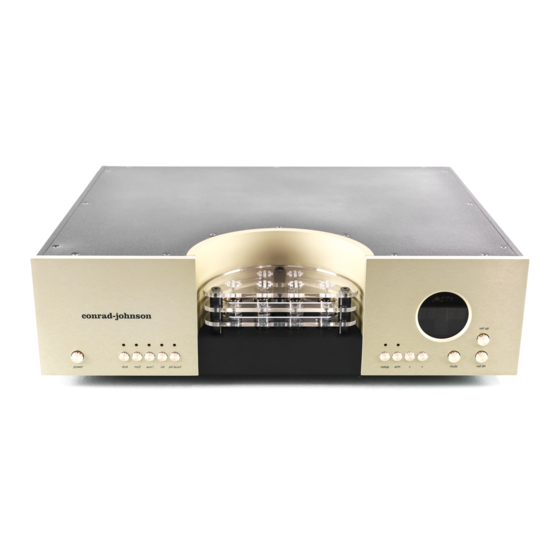Conrad-Johnson MET1 Manuel du propriétaire - Page 5
Parcourez en ligne ou téléchargez le pdf Manuel du propriétaire pour {nom_de_la_catégorie} Conrad-Johnson MET1. Conrad-Johnson MET1 14 pages. Multi-channel enhanced-triode preamplifier

I
nstallation
The first step in preparing your MET1 preamplifier for use is to
install the vacuum-tubes. To do this, remove the top plate of the
tube guard by removing the three socket-head screws using the
supplied hex-head screwdriver. The MET1 uses six type 8080
tubes. After checking the pin orientation, insert one tube in each
tube socket (the tubes are interchangeable). Next, fit two of the
included silicone rubber rings over each tube, spaced at roughly
1/3 and 2/3 distances. These rings will minimize the effects of air-
borne microphonics on the tubes. Finally, reinstall the tube guard.
Set Up
To maintain proper ventilation, mount the MET1 horizontally on a
flat, hard surface, and take care that the ventilation holes in the
bottom are unobstructed. Allow at least two inches of clearance
above the unit and keep the cabinet or shelf open at the back.
All MET1s sold in the United States are configured for operation on
a 60Hz ac power line producing between 108 and 126 volts. Export
versions of the MET1 will have the correct operating voltage and
frequency clearly marked on the back panel of the unit, near the ac
power cord. In all cases, the actual line voltage should be within +
5/- 10% of the nominal rated voltage.
Electromagnetic Interference (EMI)
Considerable care has been taken in the design of the MET1 to
minimize its susceptibility to radio frequency interference and other
forms of EMI. Choice of materials, physical layout, grounding
practice, and power supply design have all been specified with a
view to reducing the impact of electromagnetic fields on the
performance of this unit. At the same time, however, our primary
goal is the accurate reproduction of recorded music in the normal
home environment, and we have elected not to compromise this
objective by the application of heavy-handed RFI filters, or by using
grounding practices that reduce RFI at the expense of degraded
audio performance. We find that the approach we have taken has
worked extremely well, resulting in only rare instances of EMI
problems which could be treated locally as needed, rather than
compromising the performance of our product in the 99.9% of
installations where EMI is not a problem.
MET1 Owner's Manual
4
